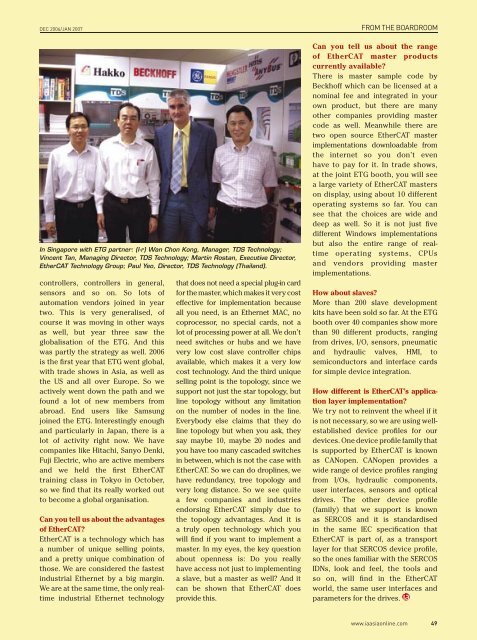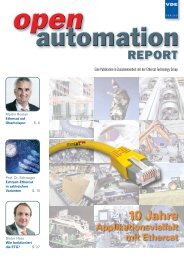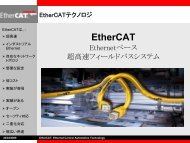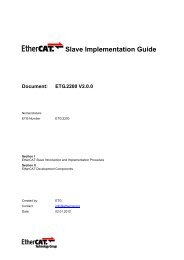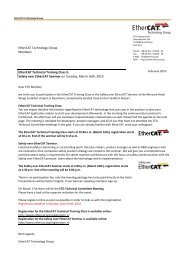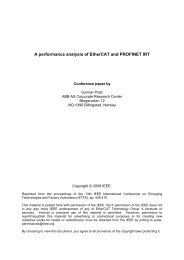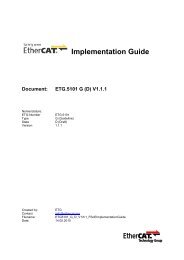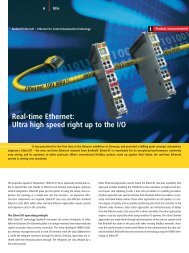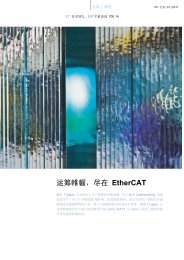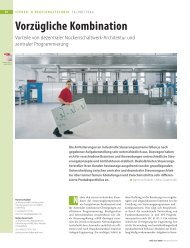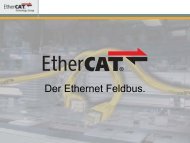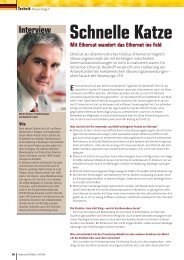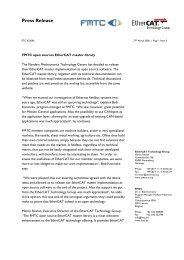English - EtherCAT
English - EtherCAT
English - EtherCAT
Create successful ePaper yourself
Turn your PDF publications into a flip-book with our unique Google optimized e-Paper software.
DEC 2006/JAN 2007<br />
In Singapore with ETG partner: (l-r) Wan Chon Kong, Manager, TDS Technology;<br />
Vincent Tan, Managing Director, TDS Technology; Martin Rostan, Executive Director,<br />
<strong>EtherCAT</strong> Technology Group; Paul Yeo, Director, TDS Technology (Thailand).<br />
controllers, controllers in general,<br />
sensors and so on. So lots of<br />
automation vendors joined in year<br />
two. This is very generalised, of<br />
course it was moving in other ways<br />
as well, but year three saw the<br />
globalisation of the ETG. And this<br />
was partly the strategy as well. 2006<br />
is the fi rst year that ETG went global,<br />
with trade shows in Asia, as well as<br />
the US and all over Europe. So we<br />
actively went down the path and we<br />
found a lot of new members from<br />
abroad. End users like Samsung<br />
joined the ETG. Interestingly enough<br />
and particularly in Japan, there is a<br />
lot of activity right now. We have<br />
companies like Hitachi, Sanyo Denki,<br />
Fuji Electric, who are active members<br />
and we held the fi rst <strong>EtherCAT</strong><br />
training class in Tokyo in October,<br />
so we fi nd that its really worked out<br />
to become a global organisation.<br />
Can you tell us about the advantages<br />
of <strong>EtherCAT</strong>?<br />
<strong>EtherCAT</strong> is a technology which has<br />
a number of unique selling points,<br />
and a pretty unique combination of<br />
those. We are considered the fastest<br />
industrial Ethernet by a big margin.<br />
We are at the same time, the only realtime<br />
industrial Ethernet technology<br />
that does not need a special plug-in card<br />
for the master, which makes it very cost<br />
effective for implementation because<br />
all you need, is an Ethernet MAC, no<br />
coprocessor, no special cards, not a<br />
lot of processing power at all. We don’t<br />
need switches or hubs and we have<br />
very low cost slave controller chips<br />
available, which makes it a very low<br />
cost technology. And the third unique<br />
selling point is the topology, since we<br />
support not just the star topology, but<br />
line topology without any limitation<br />
on the number of nodes in the line.<br />
Everybody else claims that they do<br />
line topology but when you ask, they<br />
say maybe 10, maybe 20 nodes and<br />
you have too many cascaded switches<br />
in between, which is not the case with<br />
<strong>EtherCAT</strong>. So we can do droplines, we<br />
have redundancy, tree topology and<br />
very long distance. So we see quite<br />
a few companies and industries<br />
endorsing <strong>EtherCAT</strong> simply due to<br />
the topology advantages. And it is<br />
a truly open technology which you<br />
will fi nd if you want to implement a<br />
master. In my eyes, the key question<br />
about openness is: Do you really<br />
have access not just to implementing<br />
a slave, but a master as well? And it<br />
can be shown that <strong>EtherCAT</strong> does<br />
provide this.<br />
INSTRUMENTATION FROM & THE MEASUREMENT<br />
BOARDROOM<br />
Can you tell us about the range<br />
of <strong>EtherCAT</strong> master products<br />
currently available?<br />
There is master sample code by<br />
Beckhoff which can be licensed at a<br />
nominal fee and integrated in your<br />
own product, but there are many<br />
other companies providing master<br />
code as well. Meanwhile there are<br />
two open source <strong>EtherCAT</strong> master<br />
implementations downloadable from<br />
the internet so you don’t even<br />
have to pay for it. In trade shows,<br />
at the joint ETG booth, you will see<br />
a large variety of <strong>EtherCAT</strong> masters<br />
on display, using about 10 different<br />
operating systems so far. You can<br />
see that the choices are wide and<br />
deep as well. So it is not just fi ve<br />
different Windows implementations<br />
but also the entire range of realtime<br />
operating systems, CPUs<br />
and vendors providing master<br />
implementations.<br />
How about slaves?<br />
More than 200 slave development<br />
kits have been sold so far. At the ETG<br />
booth over 40 companies show more<br />
than 90 different products, ranging<br />
from drives, I/O, sensors, pneumatic<br />
and hydraulic valves, HMI, to<br />
semiconductors and interface cards<br />
for simple device integration.<br />
How different is <strong>EtherCAT</strong>’s application<br />
layer implementation?<br />
We try not to reinvent the wheel if it<br />
is not necessary, so we are using wellestablished<br />
device profi les for our<br />
devices. One device profi le family that<br />
is supported by <strong>EtherCAT</strong> is known<br />
as CANopen. CANopen provides a<br />
wide range of device profi les ranging<br />
from I/Os, hydraulic components,<br />
user interfaces, sensors and optical<br />
drives. The other device profi le<br />
(family) that we support is known<br />
as SERCOS and it is standardised<br />
in the same IEC specifi cation that<br />
<strong>EtherCAT</strong> is part of, as a transport<br />
layer for that SERCOS device profi le,<br />
so the ones familiar with the SERCOS<br />
IDNs, look and feel, the tools and<br />
so on, will fi nd in the <strong>EtherCAT</strong><br />
world, the same user interfaces and<br />
parameters for the drives.<br />
www.iaasiaonline.com 49


